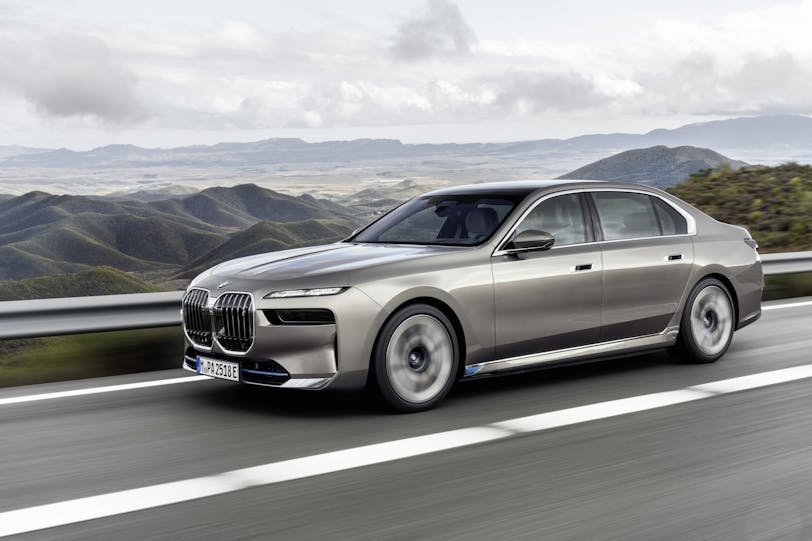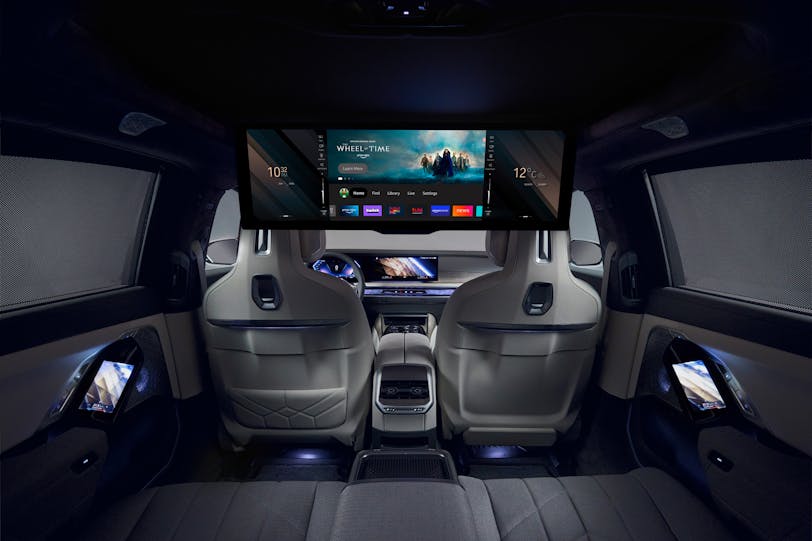BMW i7 xDrive60: electric, high-tech and controversial styling
The BMW 7 Series has traditionally been the luxury saloon chosen by someone who will be driving the car rather than be driven in it. But a new BMW 7 Series is now here, and it’s different in a number of ways.
For the first time, there’s an all-electric version, the BMW i7 xDrive60. Secondly, the focus has moved more towards technology – for example, you can specify a theatre screen for rear seat passengers that stretches virtually the entire width of the cabin (and most of the rest of the interior is comprised of screens). And thirdly, the styling is even more controversial than the 7 Series designed by Chris Bangle which went on sale in 2001.
Let’s take a look at the headlines of the all-electric BMW i7 xDrive60. It has a 101.7 kWh battery, which is due to give a WLTP driving range of 367-388 miles.

There are two electric motors (without any rare-earth metals) – one at the front producing 258hp, and one at the rear generating 313hp. This gives the i7 all-wheel drive, as well as a total power output of 544hp and 745Nm of torque, which results in a 0-62mph acceleration time of 4.7 seconds.
The i7 can also charge at a rate of up to 195 kW, allowing 106 miles of range to be added in just ten minutes at an ultra-rapid charger.
When an EV charges, it doesn’t charge at a constant rate; instead, the rate at which it can take power reduces as the battery becomes charged, and when plotted on a graph, this reduction isn’t a line - the rate drops in ‘steps’. BMW says that the i7 does away with ‘stepped’ charging, and instead the charge rate drops smoothly, which should lead to shorter charging times.
Other improvements have been made to how the car charges to increase speed and improve the battery’s life, recuperation has also been optimised, and the i7 has a heat pump, which improves the car’s driving range.
Away from the electric powertrain, the other big news is the technology in the i7. One of the highlights for rear-seat passengers is the (optional) BMW Theatre Screen with Amazon Fire TV built-in. This includes a 31.3-inch 8K touchscreen display with Bowers & Wilkins surround sound system, built-in touch screen remotes in the door panels (BMW Touch Command), and an automated rear shade system that closes when the BMW Theatre Screen is turned on. The BMW Theatre Screen folds into the ceiling so it’s out of the way when not in use, and it can be moved closer or further from the rear passengers.

For front seat occupants there’s a BMW Curved Display. The fully digital screen grouping consists of a 12.3-inch information display behind the steering wheel and a control display with a screen diagonal of 14.9 inches.
Another digital feature is the BMW Interaction Bar which extends across the full width of the instrument panel, containing controls that would previously have been physical buttons on the dashboard.
Then there’s the visual appearance of the i7. Firstly, it’s even bigger than the last model. The new BMW 7 Series has grown by 130mm in length to 5,391mm, by 48mm in width to 1,950mm and by 51mm in height to 1,544mm. Its wheelbase is now 5mm longer at 3,215mm.
And what about the styling? The BMW 7 Series from the 1990s (as per the one in the James Bond film that drove off the edge of a roof-top car park) was surely one of the best-looking 7 Series. This latest model features a huge grille and lots of ostentatious chrome work. So who has this latest 7 Series been designed for? BMW says that 70% of 7 Series sales will be in Asia, with 50% in China, so the car has been styled to appeal to those markets.
The new 7 Series is available exclusively in long-wheelbase form, in either M Sport or Excellence specification. The new fully-electric BMW i7 xDrive60 is priced from £107,400, with the first UK deliveries expected to commence from December 2022.
The BMW i7 M70 xDrive, the future flagship model, expected to have a power output of 660 hp, will follow later in 2023.